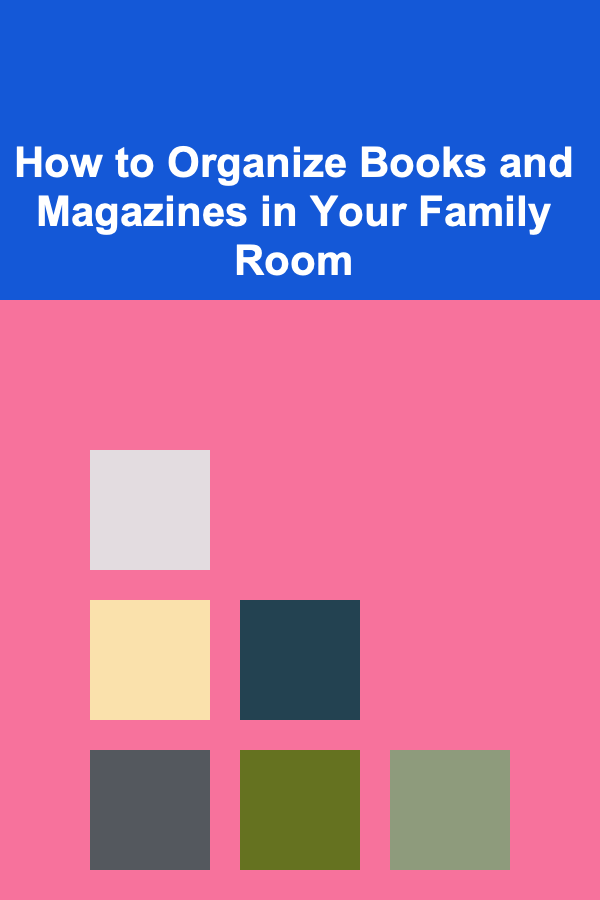
How to Organize Books and Magazines in Your Family Room
ebook include PDF & Audio bundle (Micro Guide)
$12.99$9.99
Limited Time Offer! Order within the next:

A well-organized family room can be a sanctuary for relaxation, entertainment, and family bonding. For many families, books and magazines are not just sources of information and entertainment; they are cherished items that contribute to the personality of a home. However, without proper organization, these collections can quickly become cluttered, detracting from the overall aesthetic and functionality of the space. This article explores effective strategies for organizing books and magazines in your family room, ensuring that your collection is both accessible and visually appealing.
Understanding the Importance of Organization
An organized family room enhances the ambiance of your home and promotes a sense of calm and order. When books and magazines are neatly arranged, it becomes easier to locate specific titles, making reading more enjoyable. Additionally, an organized space encourages family members to engage with the materials available, fostering a culture of reading and shared knowledge.
Moreover, organizational systems can significantly impact how we interact with our belongings. A well-curated collection can tell a story about your interests, values, and experiences, serving as a conversation starter for guests. By taking the time to organize your books and magazines, you not only create a functional space but also curate an environment that reflects your family's identity.
Assessing Your Collection
Before diving into the organization process, it's essential to assess your current collection of books and magazines. This step will guide your decisions regarding storage solutions and organizational strategies.
3.1. Types of Books and Magazines
Consider the types of materials you have. Are they primarily fiction, non-fiction, reference books, or periodicals? Different categories may require different approaches to organization:
- Fiction: Novels often lend themselves to genre-based organization.
- Non-Fiction: These texts can be organized by subject matter or theme.
- Magazines: Periodicals may need a different approach, focusing on current issues versus archival storage.
3.2. Quantity and Size
Next, evaluate the quantity and size of your collection. Do you have a few cherished volumes, or is your collection extensive? Consider the dimensions of your books and magazines as well. Oversized coffee table books may require special shelving, while smaller paperback novels can fit into tighter spaces. Take stock of what you have, noting any duplicates or items that may no longer hold value for you.
Choosing the Right Storage Solutions
Selecting the right storage solutions is crucial for creating an organized and aesthetically pleasing family room. The choice of furniture and containers can greatly influence the overall look and functionality of the space.
4.1. Shelving Units
Shelving units are one of the most versatile storage solutions for books and magazines. They come in various styles, sizes, and materials, allowing you to choose options that align with your decor. Open shelves facilitate easy access and display, making them ideal for showcasing beautiful covers or decorative items alongside your reading materials.
4.2. Storage Bins and Baskets
For a more casual and flexible approach, consider using storage bins and baskets. These can be placed on shelves, under coffee tables, or in corners of the room. Baskets can add texture and warmth to the space, while bins can offer a more streamlined look. This method is particularly useful for magazines, enabling you to group them by issue or theme while keeping them out of sight when not in use.
4.3. Bookcases and Cabinets
Bookcases and cabinets provide an excellent way to store your collection while reducing visual clutter. Closed cabinets can help protect your items from dust and damage, making them ideal for valuable or rarely accessed materials. When choosing bookcases, consider options with adjustable shelves to accommodate different book sizes.
Organizational Strategies
Once you have selected your storage solutions, it's time to decide on organizational strategies. The method you choose will depend on your personal preferences, the nature of your collection, and the overall aesthetic you want to achieve.
5.1. By Genre or Subject
One of the most common methods for organizing books is by genre or subject. This strategy makes it easy to locate specific types of materials quickly. You can create sections for fiction, non-fiction, biographies, self-help, cookbooks, and more. This approach is particularly beneficial for avid readers who often seek out particular genres.
5.2. By Author
If you have a collection that features multiple works by the same author, consider organizing them by the author's last name. This strategy can be especially effective for literary enthusiasts who enjoy exploring an author's complete works. Creating dedicated sections for beloved authors can also enhance the visual appeal of your collection.
5.3. By Color
For those who appreciate a visually striking arrangement, organizing books by color can create a stunning display. This method turns your collection into a colorful work of art, adding a unique touch to your family room. However, keep in mind that this approach may make it more challenging to locate specific titles, so it's best suited for those who prioritize aesthetics over functionality.
5.4. By Size
Organizing by size can create a clean and uniform appearance on your shelves. Grouping books and magazines by height ensures that everything fits neatly and can help maximize shelf space. This method works particularly well for mixed collections where items vary greatly in size.
5.5. Chronological Order
For certain types of collections, such as historical texts or magazines, chronological organization can be highly beneficial. This method allows you to trace the evolution of ideas or trends over time. It also provides context for your materials, helping to tell a story through your collection.
Creating a Reading Nook
A well-organized family room should include a cozy reading nook that invites family members to curl up with a good book. Here are some tips for creating a dedicated space for reading:
- Select a Comfortable Chair: Choose a chair that is comfortable and supportive for long reading sessions. Consider adding cushions or a throw blanket for added coziness.
- Adequate Lighting: Ensure your reading nook is well-lit. A floor lamp or table lamp can provide focused lighting for evening reading, while natural light is ideal during the day.
- Small Side Table: Include a small side table to hold your current reads, a cup of tea, or a notebook for jotting down thoughts. This keeps everything within arm's reach.
- Personal Touches: Add personal touches to your reading nook, such as framed photos, art, or decorative items that resonate with your family's interests.
- Proximity to Books: Ideally, your reading nook should be close to your organized books and magazines. This encourages spontaneous reading and makes it easy to grab a new title.
Designing a Magazine Display
Magazines can sometimes pose a challenge when it comes to organization due to their ever-changing nature. Here are some ideas for designing a functional and attractive magazine display:
- Rotating Displays: Consider setting up a rotating display for current issues of magazines. This keeps your collection fresh and encourages family members to read the latest editions.
- Magazine Racks: Use magazine racks or wall-mounted organizers to keep issues upright and easily accessible. This prevents damage and helps maintain a tidy appearance.
- Themed Collections: Group magazines by theme or interest area, such as travel, fashion, or cooking. This organization method can help family members quickly find what they're looking for.
- Archival Storage: For older issues that you want to keep but don't necessarily need to access frequently, consider archival boxes. These can help preserve your magazines while keeping them organized and out of the way.
Maintaining Your Organized Space
Once you've achieved an organized family room, it's essential to maintain that order. Here are some strategies for ongoing upkeep:
- Regular Purging: Periodically review your collection and remove items that no longer hold value. This could include books you've read and won't reread, outdated magazines, or duplicates.
- Set Guidelines for New Additions: Establish guidelines for acquiring new books and magazines. For instance, consider a "one in, one out" policy to prevent overcrowding.
- Scheduled Organization Sessions: Schedule regular times for organizing and tidying up your collection. This could be monthly or quarterly, depending on your needs.
- Involve the Family: Make organization a family activity. Encourage family members to take ownership of their own collections and participate in maintaining shared spaces.
Incorporating Technology
In the digital age, technology can play a significant role in managing and organizing your book and magazine collection. Here are some ways to incorporate tech solutions:
- Digital Cataloging: Consider using apps or software to digitally catalog your collection. This allows you to keep track of what you have, what you've read, and what you want to acquire.
- E-Readers and Digital Magazines: If space is limited, consider transitioning some of your collection to digital formats. E-readers and digital magazine subscriptions can save physical space while still providing access to a vast library.
- Online Communities: Engage with online communities or platforms where you can discuss books and magazines, share recommendations, and even swap items with fellow enthusiasts.
Conclusion
Organizing books and magazines in your family room is not merely a matter of tidiness; it's about creating a space that reflects your family's values and interests. By assessing your collection, choosing appropriate storage solutions, implementing effective organizational strategies, and maintaining your space, you can cultivate an inviting atmosphere that fosters a love for reading. Whether you're creating a dedicated reading nook or displaying magazines creatively, the goal is to create an environment where stories and ideas flourish. With thoughtful organization, your family room can become a haven of knowledge and inspiration for generations to come.
Reading More From Our Other Websites
- [Home Soundproofing 101] How to Soundproof Your Space as a Renter: Smart Solutions for Noise Control
- [Personal Finance Management 101] How to Use Cash Envelopes to Control Your Spending
- [Star Gazing Tip 101] Capturing the Cosmos: Essential Gear and Settings for Stunning Night Sky Shots
- [Organization Tip 101] How to Organize Photos for a Charity or Fundraiser
- [Home Staging 101] How to Stage a Luxury Home to Appeal to High-End Buyers
- [Personal Finance Management 101] How to Set Up Financial Milestones for a Successful Future
- [Home Pet Care 101] How to Create a Safe and Enriching Indoor Environment for Rabbits
- [Home Pet Care 101] How to Make Your Home Safe for Small Pets like Hamsters and Rabbits
- [Personal Care Tips 101] How to Use Soap to Reduce Inflammation in the Body
- [Personal Care Tips 101] How to Choose the Best Acne Treatment Cream for Your Skin Type

How to Budget for New Furniture and Home Decor Purchases
Read More
How to Edit and Proofread Your College Application Essays: An Actionable Guide
Read More
How to Organize Your Work from Home Setup for Comfort
Read More
How to Plan a Family Road Trip with Activities for All Ages
Read More
How To Understand the Economics of Craft Beer
Read More
How to Leverage Your Coaching Planner for Business Growth
Read MoreOther Products

How to Budget for New Furniture and Home Decor Purchases
Read More
How to Edit and Proofread Your College Application Essays: An Actionable Guide
Read More
How to Organize Your Work from Home Setup for Comfort
Read More
How to Plan a Family Road Trip with Activities for All Ages
Read More
How To Understand the Economics of Craft Beer
Read More